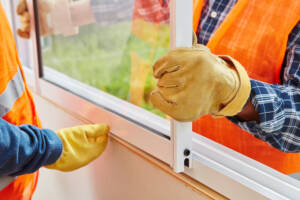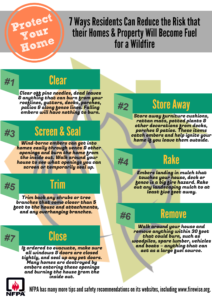Fire Resistant Windows
What types of windows do you have?
- Dual-pane windows provide better wildfire protection
-
- Depending on the type of glass, a window that is exposed to flames may break after only 1 to 3 minutes of exposure to intense heat or flames and allow flames and embers inside.
 Single-pane windows are more common in older structures.
Single-pane windows are more common in older structures.- Dual-pane windows have two sheets of glass that are separated by airspace.
- Testing has shown that single-pane windows are highly vulnerable to breaking when exposed to wildfire conditions.
- Glass in windows breaks because of extreme temperature differences, which develop between the exposed glass and the glass protected by the window framing material, when exposed to the heat from a wildfire (or the heat from your neighbor’s burning home).
- Cracks develop and propagate inward, which makes larger windows more vulnerable to breaking because they tend to have more edge than smaller windows.
Improving window performance
-
- Replace windows with dual-pane, tempered glass:
- This will provide significant wildfire protection against flames and wind-blown embers.
- These windows have the added benefits of greater energy conservation and insulation during cooler and warmer months.
- The cost increases are relative to the opening size and the number of windows that must be replaced.
- How to determine if windows have tempered glass:
- Tempered glass in a window will have a marking etched on one of the corners, similar to that shown here.
- Replace windows with dual-pane, tempered glass:
Facts about tempered glass
-
- Tempered glass is about four times more resistant to breaking during a wildfire.
- Remember, even dual-pane, tempered glass windows will not protect your house if they are left open. Close all windows before you evacuate during a wildfire.
 If replacing your windows is not an option
If replacing your windows is not an option
Managing the vegetation and other types of items that could catch fire in the areas nearest to your home or business is event more critical.
-
- This includes maintaining the surrounding vegetation and using noncombustible mulch and ignition-resistant materials for yard and garden structures.
Install window screens
-
- Metal window screens have been shown to improve the performance of windows subjected to radiant heat exposure in wildfire conditions.
- Fine mesh screens of at least 1/16-inch will also help to resist the entry of embers, but will not keep flames out.
Install shutters or create window covers
-
- If you live outside a hurricane-prone region, you will not need to install shutters.
- If your house is at risk from hurricanes and wildfires, visit the Hurricane Section and download a copy of the IBHS Shutter Selection Guide for help in choosing shutters.
- If you do not face a hurricane risk, choose a less expensive alternative for wildfire protection: ½-inch plywood.
- Measure the openings and cut covers to size.
- Label them for each window so they can be installed quickly when wildfire threatens.
- Take the time to pre-install the anchorage hardware for easier installation.
- Before installation, clear the surrounding area of vegetation and other combustible materials that could ignite the plywood covers.
Resource credit: FIRESafe MARIN
Resources
 Home Survival in Wildfire-Prone Areas: Building Materials and Design Considerations: ANR Publication 8393 15
Home Survival in Wildfire-Prone Areas: Building Materials and Design Considerations: ANR Publication 8393 15- Home Landscaping for Fire. University of California Publication 8228. 2007. University of California, Davis.
- www.readyforwildfire.org. Wildfire is Coming: Are You Ready. CAL FIRE. 2012.
- Urban Forestry Associates. Ray Moritz, Urban Forester and Fire Ecologist.
- Protecting Your Home From Wildfire. 2017. Insurance Institute for Business & Home Safety
PREPAREDNESS MENU
Prepare your Home
RESOURCES
Seven ways residents can reduce wildfire risk infographic by NFPA
Download the free wildfire safety infographic with seven tips for residents to help protect their homes in an event of a wildfire.
Wildfire risk reduction safety tips by NFPA
By working together, residents can make their own property, and their neighborhood, much safer from wildfire.


